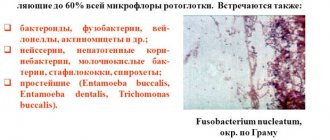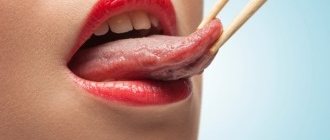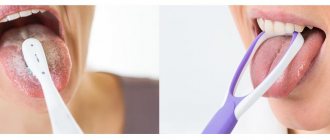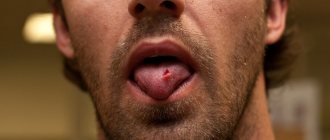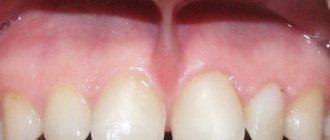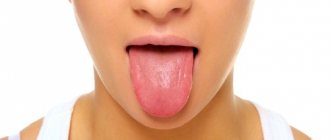Symptoms
The pathological process is accompanied by pronounced symptoms. The patient is concerned about:
- itching and burning;
- swelling of the tongue;
- pain while eating;
- decreased perception of taste;
- wounds in the mouth and corners of the lips.
As the infection progresses, white plaque spreads to the lips and inner cheeks. Gradually it takes over the entire oral cavity, moves to the throat and affects the tonsils.
At the initial stage of the disease, cheesy accumulations on the tongue can be carefully removed with a sterile bandage, but when the fungus penetrates deeper into the mucous membrane, such actions cause severe pain.
The plaque becomes dense, and when the white film separates, wounds form.
An advanced form of tongue mycosis leads to intoxication of the body with fungal enzymes. The person feels general weakness and his temperature rises.
How does candidiasis manifest on the tongue?
A fungus that appears on the surface of the tongue is called thrush. The disease causes many problems; its onset can be recognized by the characteristic white coating of a cheesy consistency that covers the surface of the tongue. Yeast fungi are able to penetrate the body from the outside, colonizing the internal mucous membranes. They do not show themselves for a long time, multiplying in cells, but once in the oral cavity, they become the cause of candidiasis.
You can recognize the fungus by the characteristic symptoms of thrush:
- burning, unpleasant sensations of itching and dry mouth, sore tongue;
- whitish spots on the mucous membrane and inflamed tongue, which is covered with a cheesy mass;
- ulcers that appear throughout the lining of the oral cavity, cracks along the edges of the mouth;
- increased body temperature due to intoxication with fungal enzymes;
- problems appear with swallowing food or saliva, and the gums turn red.
A typical manifestation of mycosis is foci of white plaque; at the beginning of the development of the disease, they can be easily removed from the tongue. However, as the disease progresses, the size of the spots increases, and removing them is already problematic. Therefore, it is necessary to start treating the fungus as early as possible, because the further development of the pathology is dangerous by affecting the entire body.
Over time, mycosis spreads across the larynx, palate, affects the cheeks, and is found on the lips, which contributes to the addition of a bacterial infection.
Provoking factors
Fungal infection of the tongue is a disease that can be transmitted through direct contact with a carrier of the infection. Infection in adults often occurs through kisses and personal belongings of a sick person.
Breasts are at increased risk because their immune defenses are unbalanced. A child who is bottle-fed is especially at risk. Infant formula is a favorable environment for yeast fungi that provoke candidiasis on the tongue.
In some cases, activation of pathogenic flora in children and adults occurs due to non-compliance with hygiene rules and in contact with animals.
For older people who wear dentures, it is important to remember that they need to be carefully maintained and cleaned regularly. Otherwise, bacteria develop in the mouth, inflammation and thrush begin.
Therapy methods
Manifestations of fungus on the tongue can be treated only after a thorough examination. To do this, you need to contact your dentist, who will conduct a visual examination and prescribe laboratory tests.
To confirm the diagnosis, scraping from the lesions is necessary to identify the type of infectious agent. If there is a suspicion that the disease has entered the stomach, the doctor may require additional tests:
- throat swab;
- endoscopy of the stomach and esophagus.
Based on the data obtained, he prescribes an individual treatment regimen, which must be strictly adhered to.
Failure to follow the recommendations can cause the disease to become chronic and cause the fungus to damage other parts of the body.
Therapy includes medications for internal use and external treatment of the oral cavity.
As an aid, many doctors recommend traditional medicine recipes that effectively relieve inflammation, inhibit the development of fungus and relieve pain.
How to treat a fungal infection on the tongue
Typically, people with candidiasis turn to a specialist if they have clearly noticeable symptoms against the background of unbearable sensations in the oral cavity. Although it is not difficult to recognize the fungus, confirmation of the diagnosis is necessary before treating it.
Therefore, the doctor prescribes additional tests:
- scraping from the tongue to accurately determine the type of fungal infection;
- blood test to determine the level of sugar in it;
- additional studies if the spread of candidiasis is suspected.
The specialist draws up an individual treatment program, since other parts of the body can also be affected by the fungal infection. It is dangerous to engage in self-therapy, since improper treatment of tongue fungus, especially the acute form, can result in the problem becoming a chronic pathology.
A common cause of mycoses is exacerbation of systemic diseases of the gastrointestinal tract, endocrine system, and HIV infection, so you will first have to cure the provoking disease or achieve a stable remission of the pathology.
Preparations for internal use
For extensive lesions, systemic drug treatment is required. Antimycotics are required for oral administration.
They are divided into 2 types:
- Polyene antibiotics. These are powerful drugs that destroy fungus not only in the oral cavity, but throughout the body. They contribute to the disappearance of curd coating on the tongue, heal microcracks and erosions. This group includes Levorin, Nystatin, Amphotericin B.
- Azoles. They have strong fungicidal and fungistatic properties and quickly stop the development of Candida fungus in the body. The most effective of them are Miconazole, Clotrimazole, Ketoconazole, Fluconazole, Itraconazole.
The doctor selects the drug and duration of treatment. On average it varies from 1 to 2 weeks. Once you start therapy, you need to complete it to avoid relapse, which inevitably occurs if the fungus is not completely destroyed.
To increase the body's defenses, vitamins C, PP, group B and calcium gluconate are prescribed. They restore the normal acidic environment in the mouth, strengthen the immune system and improve overall well-being.
Therapy includes antihistamines, for example, Suprastin or Fenkarol, iron preparations, Ferroplex and drugs that stimulate the production of leukocytes and gamma globulins, Pentoxyl, Methyluracil.
Local preparations
For external treatment, Fukortsin is used, which is effective for superficial mycoses.
- Before the procedure, you need to moisten a sterile swab in tea tree oil and gently apply it to your tongue, the inside of your cheeks and other affected areas, removing the white coating.
- Then apply Fukortsin to the diseased areas with a cotton swab, without touching healthy mucous membranes.
- 2 hours after application, the mouth should be rinsed thoroughly with warm water.
- Treatments should be carried out 3 times a day, the course should not exceed 10 days.
- Fukortsin should not be used to treat fungus on the tongue during pregnancy or in children under 2 years of age.
Lugol and Yodicirin are suitable for treating mycosis in the mouth. These drugs should be used similarly to Fukortsin.
To prevent the development of a bactericidal infection, the doctor often prescribes Lizak or Lysozyme tablets. They should be slowly dissolved, placed under the root of the tongue, until completely dissolved.
If white plaque and cracks are observed on the lips, Levorin or Nystatin ointments are recommended. The products should be applied twice a day, gently rubbing into the affected areas for at least a week. In severe cases, the course of treatment can be extended to 1 month.
Candidiasis
Most often, scraping is prescribed if there is a suspicion of infection with Candida fungus. It is he who provokes the development of thrush. The resulting material is examined under a microscope. In this case, very thin threads are revealed, which are formed by Candida pseudomycelium.
Thrush is a common oral lesion. It can provoke gingivitis, cheilitis, stomatitis, glossitis. Very often newborns suffer from such damage.
There are many reasons for infection in newborns:
- improper hygiene of the mother who is breastfeeding;
- insufficient sterilization of pacifiers and nipples;
- prematurity;
- infection during the passage of the birth canal;
- weak immune system;
- antibiotic treatment;
- avitaminosis;
- dysbiosis.
Most often, scraping is prescribed if there is a suspicion of infection with Candida fungus.
And candidiasis of the mucous membranes often appears if there are dentures in the mouth. They darken and become covered with plaque. Two forms of Candida fungus can settle in the mouth - yeast and pseudomycelium. A fairly acidic environment (pH 5.8-6.5) becomes favorable for it.
Therefore, they pose a real threat to acrylic dentures. Fungal plaque is also found on the prosthetic bed. If the prosthesis is made of metal, then its owner, when infected with the Candida fungus, begins to feel a burning sensation, a metallic taste in the mouth, and complains of paresthesia and bad breath.
The resulting material is examined under a microscope.
All this resembles mechanical damage or an allergy picture. To avoid such surprises, you need to ensure high-quality hygiene of both the oral cavity and dentures. Most often, the fungus can be found on the palate, tongue, and corners of the mouth. At the same time, the tongue begins to become coated, and there may be cracks in the corners of the mouth.
2 hours before the procedure you should not drink, eat, brush your teeth, rinse your mouth or take medications. To get the most informative results, it is best to take this test right in the morning, immediately after sleep.
Thrush very often affects newborns and infants. Here the parents are faced with the question: “How to take the material correctly?” While this does not present any difficulties for an adult, taking a scraping from a small child can sometimes be difficult.
You need to take a special spatula for the surface of the tongue or a simple cotton swab and carefully rub it across the tongue several times. The taken material must be placed in a sterile flask and sent to the laboratory. The child will not feel any discomfort.
For high-precision analysis, the material is taken in the morning.
If the scraping shows signs of Candida fungus, the doctor will diagnose “oral candidiasis.” In this case, under a microscope, cells or filaments from pseudomycelium grouped into buds will be visible.
Such a scraping also allows for analysis of bile acids. The quality of the analysis is ensured by high-tech thin layer chromatography.
For such a high-precision analysis, the material is taken in the morning. The patient should not have time to eat, drink or take medications.
Don't be afraid of this simple procedure. It consists only in the fact that in the laboratory, using an ordinary teaspoon, the plaque that has accumulated overnight is carefully removed from the tongue. Then the material is placed in a test tube, filled with ethyl alcohol and left for a while under a tightly closed lid. All components must dissolve.
Then the material is evaporated in a water bath. It should decrease in volume by half. And only one drop of the resulting extract is applied to a heated chromatographic plate. Then the plate is dried again, cooled and developed.
For treatment to be effective and quick, it is necessary to identify the disease in its early stages. If the doctor has prescribed a scraping, there is no need to postpone this procedure. It is absolutely painless and safe. Moreover, such an analysis is very informative.
In some cases, in order to make a differential diagnosis with other diseases with similar symptoms, the doctor takes a scraping from the patient’s mouth. The material is sent for histological examination and examination under a microscope.
Also, in some cases, patients are prescribed a blood test or a PCR test of the contents. It would be a good idea to check your blood for the presence of fungi.
Before you begin to treat candidiasis that forms on the tongue, you must undergo a procedure related to determining the type and stage of the disease. You should not self-medicate, as this can lead to irreparable consequences.
The presence of infection is detected through a thorough examination of the mucous membranes, as well as taking various tests:
- In laboratory conditions, plaque and mucus are scraped from all affected areas. Next, the substance is sent for research to determine the degree of health deviation from the norm.
- It is mandatory to donate blood, as this will determine the amount of sugar in the body. This is done in order to find out the true cause of fungal overgrowth, which may be excess sugar or diabetes.
When thrush of the tongue occurs, treatment is prescribed only after the results of an examination by highly specialized specialists (gynecologist and mycologist for women, endocrinologist for men) are received.
To avoid experiencing all the symptoms of candida infection in the future, you should take care of your health and follow preventive measures.
Laboratory diagnosis of candidiasis plays a decisive role in making this diagnosis.
Patients are advised to consult a doctor at the first suspicious symptoms. And not only if there are signs of damage to the genitourinary system. The fact is that a pathogenic fungus can live on any mucous membrane in the human body.
Genitourinary organs
Most often, patients require analysis for candidiasis of the genital organs, since pathogenic microorganisms settle in abundance in these areas. Both women and men suffer from symptoms of the disease. May be affected:
- bladder;
- vulva;
- uterus;
- penis;
- urethra, etc.
In some cases, if a man or woman practices anal sex, pathogenic microorganisms may be detected in the anal area.
Symptoms of deviation from the norm are always the same. First of all, patients complain about the appearance of discharge from the genitals.
The discharge is characterized as thick, abundant, most often white or light yellow in color. They smell like sour milk.
Additionally, there are often complaints of itching and burning. Pain is usually not typical for this pathology, localized in the genitourinary area. But in advanced cases, the patient may complain of pain in the lower abdomen.
Lungs
What tests are taken for candidiasis if damage is detected not to the reproductive system, but to the bronchopulmonary system? Most often, scrapings are taken from the tonsils and other parts of the respiratory tract, and sputum is also collected for examination.
Oral cavity
The oral cavity, like the lungs, is affected mainly in young children who become infected from their mothers. However, thrush in this area can also develop in an adult patient. This happens when a person with oral thrush shares a toothbrush. And also in case of oral sexual contacts, if they were not protected by condoms.
In most cases, oral thrush manifests itself as a cheesy plaque that can be found on the teeth, tonsils, cheeks, palate and other places. Plaque can form into untidy lumps, which can cause discomfort to the patient.
Because of the painful lumps, small children refuse to eat and become nervous and whiny.
Mouth rinse
Alkaline solutions and thorough disinfection of the tongue help cure the disease. Regular treatment of wounds allows you to stop the proliferation of candida and speed up tissue regeneration.
Borax in glycerin (sodium tetraborate) is suitable for rinsing. It can be purchased at the pharmacy in the form of a 20% solution.
- Before the procedure, be sure to remove the crusts from the tongue by softening them with oil and wiping them with a gauze swab.
- To rinse, add a tablespoon of salt and a teaspoon of borax in glycerin to 250 ml of cooled boiled water.
- Stir and use 2 times a day.
Boric acid is useful for disinfection. Its 2% aqueous solution is used to wipe the affected areas and rinse 3-4 times a day.
A good remedy for white plaque on the tongue in adults and children is Iodinol. This is an effective antiseptic that destroys bacteria and yeast, consisting of molecular iodine and polyvinyl alcohol. For rinsing, the drug must be diluted in water (proportions: 1 tablespoon per 200 ml).
For children, the amount of product should be reduced by half. Treatment is carried out 3-4 times a day for no more than 5 days.
Traditional methods
In combination with traditional treatment, folk recipes are recommended. They help to cope with the disease faster and reduce symptoms.
- You can use onion juice. The product is applied to the mucous membranes, previously cleared of films, 3 times a day for a week.
- Natural thickened honey helps eliminate contagious diseases. It is useful to dissolve it slowly, placing a small amount under the tongue, or apply directly to the affected areas for 15-20 minutes.
- You can relieve the symptoms of candidiasis with aloe pulp. You need to place the cut bottom leaf of the plant in the refrigerator for a couple of hours. Then wash and trim the outer part of the leaf, leaving the tender pulp. You need to apply it to your tongue and try not to remove it for half an hour. The method brings quick relief, removes pain and burning. It is allowed to wipe the oral cavity with juice, mixing it with natural honey 1:1.
Medicinal herbs
Herbal decoctions and infusions can cause an allergic reaction, so before using recipes you need to make sure that there is no allergic reaction. Plants with antimicrobial and antifungal properties are suitable for rinsing:
- oak bark;
- St. John's wort;
- calendula flowers;
- wild rosemary
To make a decoction, you need to take a spoonful of any raw material, add 200 ml of water and simmer in a water bath for 15 minutes. Cool, pass through cheesecloth and rinse 4-5 times a day until the signs of fungus on the tongue disappear.
Baking soda
If thrush in the mouth appears in a baby, treatment should be prescribed by a doctor. Baking soda can be used as an adjunct to therapy. Its effect soothes pain, burning and inhibits fungal flora.
Dissolve half a teaspoon of soda in a glass of warm boiled water. Moisten a sterile bandage, wrap it around your finger and carefully apply the liquid to your tongue, palate and inner surface of your cheeks.
Treatment should be carried out 4-5 times a day for about a week.
This method is also useful for adults. The concentration of soda in water should be increased to 1 tablespoon.
Treatment of tongue fungus
Traditional methods
In the initial stages of the disease in young children, using a soda solution may be sufficient to combat the fungus. A teaspoon of soda should be diluted in a glass of boiled water and treated the affected areas in the mouth and tongue. The spread of fungus in an environment created by a soda solution is difficult, therefore, the disease will recede.
For adults, medicinal herbal teas can provide effective first aid, which also heal lesions. Yogurts can restore beneficial microflora and thereby dislodge fungus from the tongue. Such universal medicinal ingredients as lemon, honey, garlic, and onion will also help in this case if you add them all together to boiled water. Carrot juice is rich in many essential oils and is known as a recognized folk remedy in the fight against fungus. Folk remedies also include calendula tincture, freshly squeezed onion juice, and St. John's wort decoction.
Taking local and general medications without the doctor’s knowledge is prohibited, especially when treating children.
Diet
Activation of pathogenic microflora leads to painful sensations when swallowing food. Some foods provoke additional irritation of the mucous membrane and increase the symptoms of the disease.
To speed up recovery, you should exclude sour and salty foods from your diet. Steam the food and consume it in a warm, semi-liquid form.
During treatment you should avoid the following products:
- with yeast in the composition;
- fat meat;
- sweets;
- smoked food;
- semi-finished products;
- fast food;
- carbonated drinks;
- strong tea and coffee.
It is necessary to limit the consumption of sour and sweet fruits and eat small portions of food. It is advisable to include viscous porridges, lean fish, stewed vegetables, and nuts in your diet. It is useful to make chamomile tea, drink cranberry or blueberry juice. Food should be seasoned with olive oil.
After recovery, it is recommended to follow a diet for several months and gradually add dangerous foods to your diet. This will help avoid a new outbreak of fungal activity and relapse.
Diet for tongue fungus
The healing process can be slowed down by consuming foods that create microflora favorable to the fungus. Therefore, diet is an integral element of treating the disease. It is strictly forbidden to consume products containing yeast or confectionery products. Additionally, it is undesirable to eat acidic foods, because they create an appropriate environment in the oral cavity that is favorable for the parasite. Solid food can further injure the already sensitive mucous membrane, as well as hot food, so it is better to forget about it during treatment.
